2019 Oregon ACP Resident Presentations

OHSU Internal Medicine Resident Clinical and Research Abstract Presentations
American College of Physicians Oregon Chapter Scientific Meeting
November 7, 2019 ~ Salem, Oregon
Winners
Oral Clinical Vignette Presentations:
SECOND place—Dr. Jacqueline Levene (“When Flushing Leaves You Flustered”)
THIRD place—Dr. Jonathan Taylor (“The Temple of Doom”)
Clinical Vignette Poster:
THIRD place—Dr. Jenna Anderson (“NSAID-induced Acute Liver Failure—A Forgotten Culprit”)
Basic Research:
SECOND place—Dr. Simone Decker (“Modulation of brain transciptome by combined histone deacetylate inhibition and plasma treatment following traumatic brain injury and hemorrhagic shock”)
Oral Presentations
When Flushing Leaves You Flustered
Jacqueline Levene, DO
Resident collaborators: Claire Groth, MD; Ellen Green, MD
Faculty Mentor: Peter Sullivan, MD
Autonomic dysreflexia (AD) is most often described in spinal cord injury patients with lesions at or above the level of T6. AD is the result of uninhibited sympathetic reflex due to loss of central inhibition triggered by stimuli below the level of T6, such as bladder or bowel wall stretch. Autonomic dysreflexia differs from the more commonly seen dysautonomia in MS patients in that it is associated with flushing and hypertension, with hypertensive crisis being a known complication.
Temple of Doom
Jonathan Taylor, MD
Faculty Mentor: Michelle Stacey, MD
Giant cell arteritis (GCA) is a very rare cause of stroke, but is crucial to identify given its specific curative therapy and accompanying poor prognosis if left untreated. While known to predominantly affect the temporal arteries, and classically presenting with headache and visual disturbances, clinical manifestation of GCA are highly variable due to the diverse range of affected vessels. Vertebral artery involvement is particularly uncommon, with presenting symptoms generally consistent with insults to the posterior cerebral vasculature.
Clinical Vignette Posters
NSAID-Induced Acute Liver Injury: A Forgotten Culprit
Jenna Anderson, MD
Faculty Mentor: Patricio Riquelme, MD, PhD; Brian Brinkerhoff, MD
Non-steroidal anti-inflammatory drugs (NSAIDs) are some of the most widely used medications across the world. NSAID-induced hepatotoxicity is a rare entity with the incidence reported to be between 1 to 9 cases per 100,000 persons exposed. NSAID-induced hepatotoxicity is an uncommon but potentially serious adverse drug reaction. When considering the cause of acute liver injury, close evaluation of a patient’s medications, including over-the-counter agents, should be completed. Caution should be maintained when recommending NSAIDs, particularly to those with underlying liver disease.
Asad Arastu, MD; Malinda West, MD
Faculty Mentor: Thomas DeLoughery, MD
This case demonstrates a medical problem due to an unusual cause: thrombocytopenia and acute kidney failure due to a bacterial infection from suspected rural community well water contamination. Leptospirosis is a zoonosis from the genus Leptospira that spreads through the urine of infected animals. Humans may come in contact with Leptospirosis via contact with water, soil, or food. While animals may exhibit no symptoms, the bacteria has a wide range of manifestations in humans. Fever and myalgias are the most common symptoms, and patients may decompensate into multiorgan failure. This case demonstrates the importance of a thorough history and understanding patients’ individual risk factors.
Cutaneous Manifestations of Disseminated Gonococcal Infections: Petechiae, Pustules, and Purpura
Joel Burnett, MD; Janel DeSalvo, MD
Faculty Mentor: Jacob Luty, MD
Disseminated gonococcal infection (DGI) most commonly occurs in sexually active young people, and is estimated to occur in 0.5-3.0 % of patients that have mucosal infections. Risk factors for DGI include female sex, asymptomatic mucosal infection, multiple sexual partners, and HIV infection. DGI presents as one of either an arthritis-dermatitis syndrome or suppurative arthritis. Classically, the arthritis-dermatitis syndrome involves constitutional symptoms, tynosynovitis, polyarthralgias, and papulopustular skin findings, though cutaneous manifestations may be highly variable. In this case, the petechial rash represented a variant cutaneous finding
When in Doubt, Always Get the CBC with Diff
Johnny Cai, DO; Deron Amador, MD
Faculty Mentor: Daniel Morris, MD
Peripheral eosinophilia has a wide differential including common and uncommon presentations. Here we present an atypical cause of eosinophilia and discuss its general approach. In the clinical approach to rash with eosinophilia, several broad categories should be considered which involve assessment for primary hematologic conditions as well as drug and parasite mediated secondary causes. While CBC differentials are easy to dismiss and are often not obtained on routine labs, our case underscores the importance of paying a close attention to such details as both benign and life-threatening conditions can hinge upon such information.
Bloody Hell: Viral Hemorrhagic Cystitis in a Renal Transplant Recipient
Mareli Coetzer, DO
Faculty Mentor: Peter Sullivan, MD
Hemorrhagic cystitis in post-renal transplant patients is commonly associated with cytomegalovirus, Epstein-Barr virus, and polyoma virus, though can rarely be caused by adenovirus. Adenovirus species B serotypes 11 and 21 have classically been associated with acute hemorrhagic cystitis in children, and serotypes 11, 34, and 35 can rarely cause hemorrhagic cystitis and tubulointerstitial nephritis in immunocompromised adults, most commonly bone marrow transplant patients. AHC usually presents in the first year after renal transplantation, is self-limited, and most patients fully recover within 4 weeks.
Carcinoid Heart Disease: a Rare Cause of Severe Isolated Right Heart Failure
Simone E. Dekker, MD, PhD, O’Neil Mason, MD, Cody L. Ballard, PA
Faculty Mentor: Brian Davidson, MD
Carcinoid tumors are rare (2.5-5 per 100,000 per year) neuroendocrine tumors that typically arise in the gastrointestinal tract. They are often (30-40%) associated with episodic flushing, secretory diarrhea, bronchospasm, and hypotension - the carcinoid syndrome. Cardiac involvement occurs in 20-50% of patients with carcinoid syndrome and is associated with worse clinical outcome. In severe CHD with extensive systemic disease, such as in this clinical vignette, TV replacement is indicated with a primary goal of symptomatic improvement but without significant survival benefit.
More than Skin Deep: Ecthyma Gangrenosum, a Cutaneous Manifestation of Systemic Infection
Janel DeSalvo, MD; Joel Burnett, MD
Faculty Mentor: Stephanie Halvorson, MD
Ecthyma gangrenosum (EG), Latin for “necrotic pustule”, is an erythematous or purpuric macule that rapidly progresses into a hemorrhagic bulla. Clinicians should consider a differential diagnosis that includes warfarin-induced skin necrosis, cocaine-induced skin necrosis, calciphylaxis, septic emboli, disseminated intravascular coagulation, and diabetic microangiopathy, among others. Management of EG lesions involves, initially, aggressive empiric antibiotic treatment of the underlying systemic infection, with coverage for Pseudomonas being critical. After identification of causative organisms, specific antimicrobial therapy based on culture data should be employed. In some cases, surgical debridement of the necrotic lesions is also necessary.
Clinical Reasoning in the Absence of a (quantiFERON) Gold Standard
Claire Groth, MD, Hunter Spencer, DO
Faculty Mentor: Luke Strnad, MD
Introduction:
World-wide, spinal tuberculosis (Pott’s Disease) is a frequent manifestation of extra-pulmonary tuberculosis and should be considered in the assessment of back pain in patients with tuberculosis risk factors. As this case illustrates, a sufficiently high pre-test probability effects the likelihood of making a diagnosis more than any single diagnostic test. In young patients with high likelihood of tuberculosis exposure presenting with back pain and constitutional symptoms, the diagnosis of spinal TB can be supported by typical radiographic findings and response to therapy, and treatment may be warranted even in the absence of confirmatory microbiologic and histologic data.
Leptomeningeal Carcinomatosis: a Rare Manifestation of Metastatic Prostate Adenocarcinoma
Claire Groth, MD
Faculty Mentor: James Clements, MD
Leptomeningeal carcinomatosis, malignant spread to the pia-arachnoid, is an exceedingly rare complication of prostate cancer, with some studies noting a prevalence of 0.03% in this malignancy.1 It is more common in breast cancer (5%), small cell lung cancer (9-25%), and melanoma (23%).2 While uncommon, it is an important diagnosis to recognize as treatment may provide some stability to its clinical sequelae. Additionally, incidence is expected to increase as novel therapies increase the longevity of those living with prostate cancer
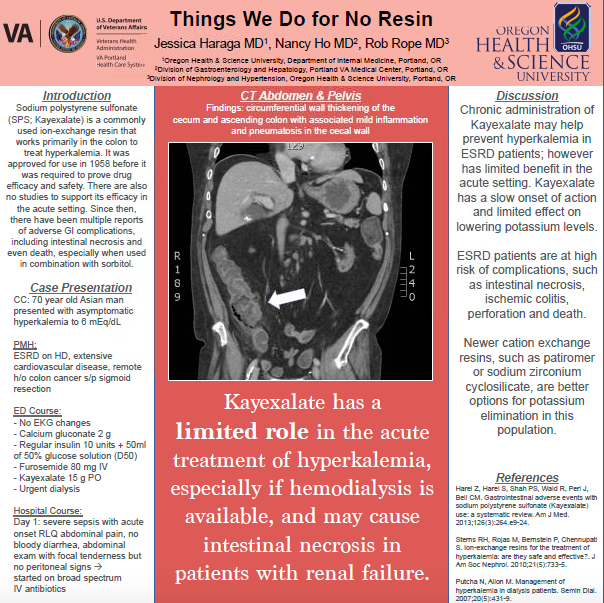
Jessica Haraga, MD
Sodium polystyrene sulfonate (SPS; Kayexalate) is a commonly used gastrointestinal binding resin to treat hyperkalemia. However, it has a slow onset of action making it a poor choice of questionable utility during acute treatment of hyperkalemia. Furthermore, those at highest risk of developing hyperkalemia (patients with kidney dysfunction) are also highest risk for serious side-effects such as intestinal necrosis (although rare).
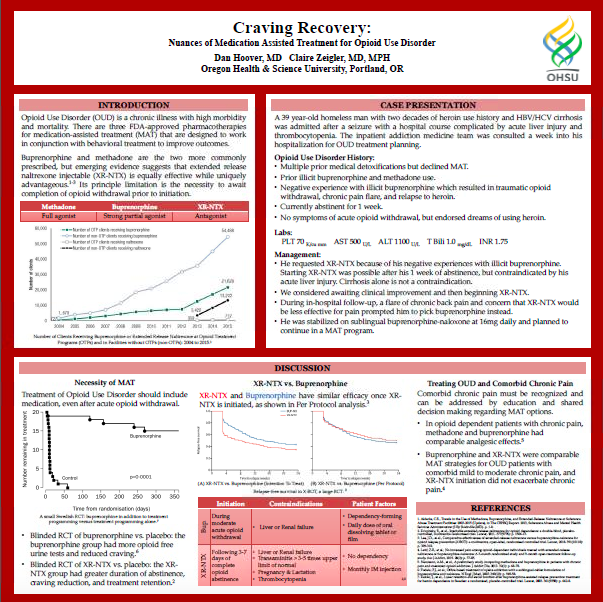
Craving Recovery: Nuances of Medication Assisted Treatment for Opioid Use Disorder
Dan Hoover, MD
Faculty Mentor: Claire Zeigler, MD, MPH
Opioid Use Disorder (OUD) is a chronic illness with high morbidity and mortality. There are three FDA-approved pharmacotherapies and each has a unique mechanism of action at the opioid receptor: buprenorphine is a high-affinity partial agonist, methadone is a full agonist, and naltrexone is an antagonist. Buprenorphine and methadone are more commonly prescribed, but emerging evidence suggests that extended release naltrexone injectable (XR-NTX) can be equally efficacious and uniquely advantageous. A limitation of XR-NTX is the necessity to await the completion of opiate withdrawal before use to avoid causing a precipitated withdrawal syndrome by abrupt antagonism of opioid receptors.
Bigger Is Not Always Better: A Case of Dialysis Graft Associated High-Output Heart Failure
R. Logan Jones, MD
Faculty Mentor: Thomas J. Prendergast, MD
High-Output Heart Failure (HOHF) is characterized by clinical heart failure and a documented cardiac index greater than 3.9 L/min/m^2. As the prevalence of diseases associated with HOHF increase (obesity, liver, and renal disease), clinicians should be mindful of this often-overlooked diagnosis. This case demonstrates the importance of a broad differential diagnosis for acute onset dyspnea in a patient with multiple comorbid processes. Particular attention should be paid to temporal correlations between surgical interventions and symptom onset. Notably, as our patient experienced, arteriovenous fistula and grafts for hemodialysis are associated with HOHF and should be urgently evaluated before permanent cardiovascular compromise occurs.
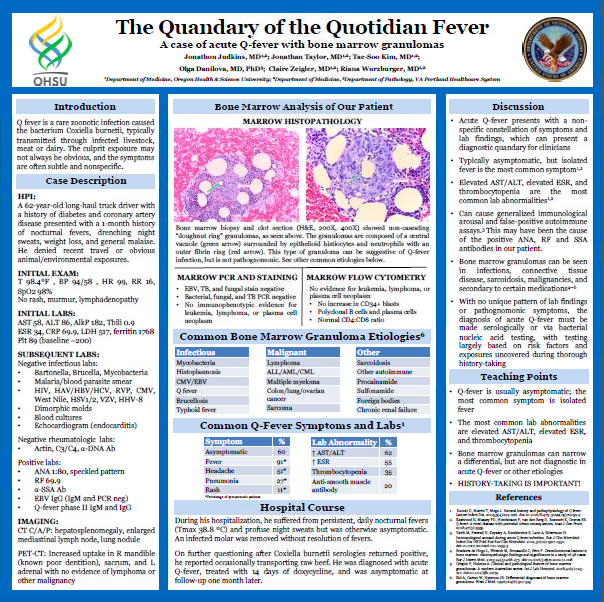
The Quandary of the Quotidian Fever
Jonathon Judkins, MD; Jonathan Taylor, MD; Taesoo Kim, MD; Riana Wurzburger, MD
Faculty Mentor: Claire Zeigler, MD, MPH
Rarely seen in America, Q-fever typically presents with a non-specific constellation of symptoms, which can result in a diagnostic quandary for clinicians. The majority of adults are asymptomatic but isolated fever is the most common presentation when symptomatic. Acute Q-fever is also known to cause generalized immunological arousal, which can lead to false-positive autoimmune assays and create additional diagnostic uncertainty. Without a unique pattern of lab findings or pathognomonic symptoms, the diagnosis of acute Q-fever must be made serologically, with testing largely based on risk factors and exposures uncovered during thorough history-taking.
The Dark Side of Caffeine: Going Beyond Arrhythmias
Maedeh Khayyat Kholghi, DO, MSc
Faculty Mentor: Alan J. Hunter, MD
Caffeine is one of the most commonly used psychostimulants and is consumed by almost 90% of United States population. In healthy adults consuming moderate amounts of caffeine is known to be safe, however toxicity and fatalities have been seen with intake of large amounts. This case illustrates the clinical features of caffeine intoxication that extends beyond arrhythmias including metabolic disturbances that persisted more than 20 hours after ingestion. Though most reported mortalities are due to arrhythmias or stroke, metabolic derangements should not be overlooked.
Reactive Arthritis Caused by Clostridium difficile Enterocolitis
Morris Kim, MD
Faculty Mentor: Brandon Mauldin MD, MHS
Reactive arthritis is an inflammatory arthritis that develops in response to an infection in a different part of the body. Though most commonly associated with infections caused by Chlamydia, Salmonella, Shigella, Campylobacter, and Yersinia, a small number of reports have shown association with Clostridium difficile. This case illustrates the potential for reactive arthritis due to C. diff in patients who are HLA-B27 negative. Though it’s important to first rule out other differential diagnoses, recognition of the possibility of reactive arthritis due to C. diff can help internists reduce unnecessary hospital work-up and length of stay.
Unexpected Coronary Angiographic Findings in a Patient with Wellens’ Sign
Morris Kim, MD; Jenna Petersen, MD; Jonathan Taylor, MD; Harrison Sapper, MD
Faculty Mentor: Ignatius Zarraga, MD
Recognizing Wellens’ sign in the EKG of a patient with unstable angina carries significant prognostic importance because it is strongly associated with high-grade stenosis of the proximal LAD and if not worked up and treated promptly, could lead to a large anterior wall myocardial infarction. The angiographic findings in this patient were unusual in that the significant coronary stenoses were found in the LCx and RCA and not in the LAD. This case adds to the small number of published reports describing Wellens’ sign in the absence of significant LAD stenosis.
Alcoholic Hepatitis and Preventing Patients from Reaching the Pint of No Return
Justin Lewis, MD
Faculty Mentor: Judith Collins, MD
Alcoholic hepatitis (AH) results from long-term alcohol abuse that leads to liver inflammation and impaired hepatic function. Abstinence from drinking is of utmost significance for these patients. Thus, getting AH patients to stop drinking is the most beneficial treatment for their health, and a deliberate effort utilizing integrated, multidisciplinary care can achieve this. One could even argue that resources should go towards inpatient rehabilitation for these patients, rather than treating end stage liver disease after relapse; further studies are needed to investigate this hypothesis
You’re Tearing Me Apart: When the Uterus Gets Infected
Erik Liederbauer, MD; Ryan Threadgill, MD
Faculty Mentor: Carrie Sailer, MD
We describe an unusual case of sepsis secondary to pelvic inflammatory disease in a patient with multiple possible sources of infection. This case serves as an opportunity to review the differential diagnosis of lower abdominal pain in a woman of child bearing age, the diagnostic criteria for pelvic inflammatory disease, and highlights the importance of obtaining a comprehensive sexual history, performing a pelvic examination if indicated, and screening for STI in the setting of sepsis of unknown etiology.
Neutrophilic Dermatoses: Not as Sweet as it Sounds
Cassandra Mullen, MD
Faculty Mentor: Curtis Lachowiez, MD
Sweet’s Syndrome (SS)- a category of neutrophilic dermatoses- is characterized by the abrupt appearance of painful, edematous and erythematous papules on the skin and fever often associated with underlying hematologic malignancies or autoimmune diseases. This case illustrates the diagnostic pitfalls associated with an uncommon condition, and highlights the importance of the history and physical exam. In this case, the discovery of the rash, despite no subjective complaint from the patient and his associated hematological malignancy was key to establishing the diagnosis.
The Hunt for Pyrexia—When Sepsis Meets Serotonin
Matthew O’Donnell, DO
Serotonin syndrome (SS) is a rare, life-threatening condition that manifests with pyrexia, autonomic hyperactivity, and neuromuscular abnormalities. This case illustrates an uncommon cause of fever in the ICU, the effects of combined serotonergic agents, and prompt management of SS. Despite ongoing fever, only when the patient displayed hypertonia, hyperreflexia, myoclonus, did we suspect SS. SS remains underrecognized and can be fatal. Prompt management can lead to resolution of symptoms within 24 hours.
Trich-y Rash in the Immunosuppressed
Ishan A. Patel, MD
Atypical infections in the immunosuppressed population is a diagnostic challenge especially in the setting of skin-related disorders. The differential can be broad and cumbersome. Especially in the era of increased frequency of immunosuppression, arriving at the diagnosis is especially prudent. As increases of solid organ transplantation occurs in the general population – along with increased use of potent immunosuppressive medications – it is important to recognize emerging causes of atypical infections in this special population. Identification and treatment of these infections is prudent especially because there is limited long-term information about the natural history of these particular diseases.
Calm Before the Storm: Bradycardia due to Hypothyroidism
Christine Rutlen, MD
Faculty Mentor: Stephanie Halvorson, MD
While hypothyroidism is a more common diagnosis in the general adult population, it often presents with a variety of symptoms. This case is notable as the patient had been asymptomatic prior to presentation and had recently undergone surgery with general anesthesia and no adverse effects, but presented with significant effects related to his disease.
At the Junction - Myasthenia Gravis as a Presentation of Graft-Versus-Host-Disease
Max Rusek, MD
Graft-verus-host disease (GVHD) is a multisystem disorder that is a well recognized complication of allogeneic hematopoietic cell transplant (HCT), with myasthenia gravis (MG) as an uncommon manifestation of GVHD. A thorough diagnostic approach for patients with GVHD is required given the multisystem nature of the disease, and particularly for symptoms of weakness. This case illustrates a rare complication of GVHD and the need for an approach to weakness that includes a broad differential diagnosis.
An Unusual MI: Intricacies of Management for the Patient with Spontaneous Coronary Artery Dissection
Harrison Sapper, MD; Maedeh Khayyat Kholghi, DO, MSc
Faculty Mentor: Brian Davidson, MD
Spontaneous Coronary Artery Dissection (SCAD) is an under diagnosed condition defined by non-traumatic, non-iatrogenic dissection of the coronary artery wall not attributable to atherosclerosis. SCAD typically presents as ACS in healthy young women. The timely diagnosis of SCAD is important in patients with ACS because it alters management when compared with atherosclerotic disease. Definitive diagnosis of SCAD can be difficult but is typically made during angiography and can be facilitated with intracoronary imaging. Physicians should have a high index of suspicion for SCAD in young women presenting with MI and be aware of the alterations in management when compared to atherosclerotic disease.
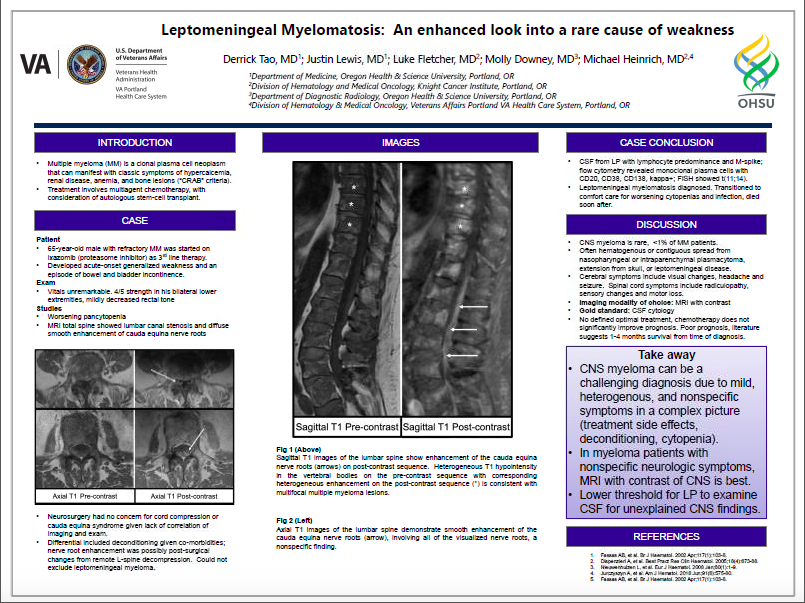
Leptomeningeal Myelomatosis: An enhanced look into a rare cause of weakness
Derrick Tao, MD; Justin Lewis, MD; Luke Fletcher, MD
Faculty Mentor: Michael Heinrich, MD
CNS myeloma is a rare site of MM disease, occurring in 1% of MM patients. CNS myeloma can be due to hematogenous and contiguous spread. It is often classified into four groups: those arising from nasopharyngeal plasmacytoma, intraparenchymal plasmacytoma, lesions extending from skull inward, and leptomeningeal disease which is most common. The OS from the diagnosis of CNS MM is variable, but most of the literature suggests about 1-4 months from time of diagnosis to death. There is no defined optimal treatment for CNS MM and treatment does not significantly improve prognosis.
Ryan Threadgill, MD
Faculty Mentor: Timothy Flynn MD
Atopic dermatitis is a commonly encountered problem in the primary care clinic. It is generally a clinical diagnosis based on history and physical and it therefore can be confused with diseases that mimic its presentation. This case highlights a patient who presented with what was thought to be atopic dermatitis but turned out to be mycosis fungoides, a skin limited form of Cutaneous T-Cell Lymphoma (CTCL). It serves as an opportunity to review common mimics of atopic dermatitis and key features of mycosis fungoides.
Painstaking Diuresis: Hyperalgesia from Bumetanide
Erik David Wells, MD
Faculty Mentor: Joseph C. Chiovaro, MD
Bumetanide is a commonly used diuretic that is generally well tolerated. However, there are rare reports of total body hyperalgesia resulting from continuous bumetanide infusions. Musculoskeletal pain syndromes are a known but poorly understood side effect of bumetanide and usually occur with continuous infusion and resolve when stopped.
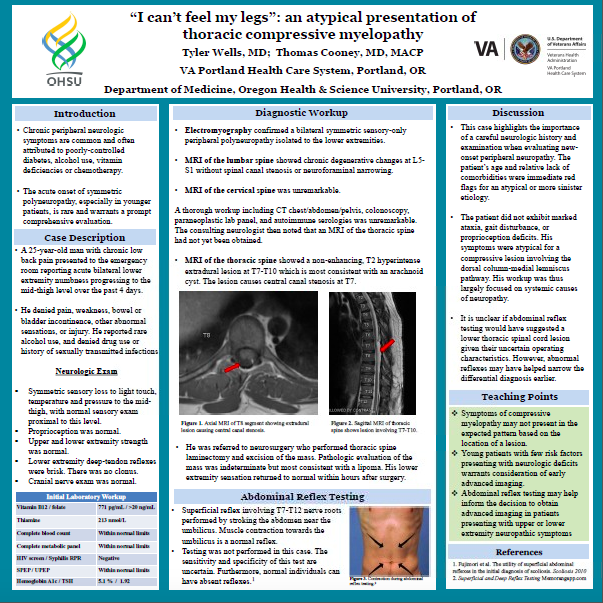
“I can’t feel my legs”: An Atypical Presentation of Thoracic Compressive Myelopathy
Tyler Wells, MD
Faculty Mentor: Tom Cooney, MD
Peripheral neurologic symptoms are a common problem in the primary care setting. While symmetric peripheral neuropathy is common, frequently attributed to poorly controlled diabetes, chemotherapy, chronic alcohol abuse, or vitamin deficiency, the acute onset of symmetric peripheral neuropathy presents a unique diagnostic challenge requiring a prompt and comprehensive evaluation. This case highlights the importance of a careful neurologic history and examination when evaluating new-onset peripheral neuropathy. Despite best efforts, atypical presentations or cognitive biases can delay diagnosis.
Hanging on By a (Fibrin) Thread
Rachel Westwood, MD
Faculty Mentor: Kyle Kent, MD
Patent foramen ovale (PFO) is a recognized cause of cryptogenic embolic stroke. Paradoxical embolism typically occurs when the right atrial pressure exceeds the left atrial pressure, which can occur with acute pulmonary hypertension in the setting of pulmonary embolism. An entrapped embolus straddling the foramen ovale with imminent paradoxical embolism is an exceedingly rare occurrence with significant morbidity and mortality. An inter-atrial thrombus in transit is an extremely rare event and there is no consensus about the best management.
Quality Improvement Posters
R. Logan Jones, MD
Faculty Mentor: Avital O’Glasser, MD
Research presentations and clinical vignettes often make their first appearance at scientific meetings. Previous studies have attempted to evaluate the transmission from abstract level presentation at national meetings to widely disseminated scholarly works. However, there is limited literature on the topic of the translational effect of research presented at local or regional internal medicine meetings. The American College of physicians supports both chapter level and national level abstract competitions for medical student and resident learners. The goal of this project was to better understand the rate at which projects presented at the Annual Oregon ACP Chapter go onto wider scholarly formats.
Clinical Research Posters
Estimation of U.S. Patients with Cancer Who May Respond to Cytotoxic Chemotherapy
Edward B. Maldonado, MD; Scott Parsons, DO; Emerson Y. Chen, MD; Alyson Haslam, PhD
Faculty Mentor: Vinay Prasad, MD, MPH
Oncology drug development has shifted away from cytotoxic agents, while they remain widely used in clinical practice. We sought to estimate the proportion of U.S. patients with advanced or metastatic cancer who are eligible for and may respond to standard first-line cytotoxic chemotherapy alone based on National Comprehensive Cancer Network (NCCN) treatment guidelines. Given the large role of cytotoxic agents in cancer, drug development in this space may remain of interest in specific cancer types, and the regulatory approval of novel oncology drugs may justify head-to-head comparisons against cytotoxic regimens.
Basic Research Posters
Modulation of brain transcriptome by combined histone deacetylate inhibition and plasma treatment following traumatic brain injury and hemorrhagic shock
Simone Dekker, MD